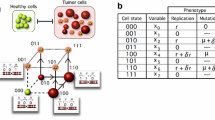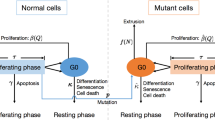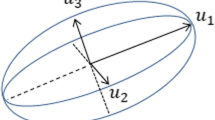Abstract
Oncogenic hyperplasia is the first and inevitable stage of formation of a (solid) tumor. This stage is also the core of many other proliferative diseases. The present work proposes the first minimal model that combines homeorhesis with oncogenic hyperplasia where the latter is regarded as a genotoxically activated homeorhetic dysfunction. This dysfunction is specified as the transitions of the fluid of cells from a fluid, homeorhetic state to a solid, hyperplastic-tumor state, and back. The key part of the model is a nonlinear reaction-diffusion equation (RDE) where the biochemical-reaction rate is generalized to the one in the well-known Schlögl physical theory of the non-equilibrium phase transitions. A rigorous analysis of the stability and qualitative aspects of the model, where possible, are presented in detail. This is related to the spatially homogeneous case, i.e. when the above RDE is reduced to a nonlinear ordinary differential equation. The mentioned genotoxic activation is treated as a prevention of the quiescent G0-stage of the cell cycle implemented with the threshold mechanism that employs the critical concentration of the cellular fluid and the nonquiescent-cell-duplication time. The continuous tumor morphogeny is described by a time-space-dependent cellular-fluid concentration. There are no sharp boundaries (i.e. no concentration jumps exist) between the domains of the homeorhesis- and tumor-cell populations. No presumption on the shape of a tumor is used. To estimate a tumor in specific quantities, the model provides the time-dependent tumor locus, volume, and boundary that also points out the tumor shape and size. The above features are indispensable in the quantitative development of antiproliferative drugs or therapies and strategies to prevent oncogenic hyperplasia in cancer and other proliferative diseases. The work proposes an analytical-numerical method for solving the aforementioned RDE. A few topics for future research are suggested.
Similar content being viewed by others
References
Abbot, A. (2003). Biology's new dimension. Nature 424(21 August): 870–872.
Akabani, G., R.E. McLendon, D.D. Bigner and M.R. Zalutsky (2002). Vascular targeted endoradiotherapy of tumors using alpha-particle-emitting compounds: Theoretical analysis. Int. J. Radiation Oncology Biol. Phys. 54(4): 1259–1275.
Albano, A.M., N.B. Abraham, D.E. Chyba and M. Martelli (1984). Bifurcations, propagating solutions, and phase transitions in a nonlinear chemical reaction with diffusion. Am. J. Phys. 52(2): 161–167.
Antipas, V.P., G.S. Stamatakos, N.K. Uzunoglu, D.D. Dionysiou and R.G. Dale (2004). A spatio-temporal simulation model of the response of solid tumours to radiotherapy in vivo: Parametric validation concerning oxygen enhancement ratio and cell cycle duration. Phys. Med. Biol. 49: 1485–1504.
Baucke E., R. Behrends, K. Fuchs, R. Hagen and U. Kaatze (2004). Kinetics of Ca2+ complexation with some carbohydrates in aqueous solutions. J. Chem. Phys. 120(7): 8118–8124.
Bellomo, N., A. Bellouquid and E. De Angelis (2003a). The modelling of the immune competition by generalized kinetic (Boltzmann) models: Review and research perspectives. Mathl. Comput. Modelling 37(1–2): 65–85.
Bellomo, N., N. Calander, E. Mamontov and M. Willander (2003b). The generalized-kinetics-based equilibrium distribution function for composite particles, Comptes Rendus Mecanique 331(7): 461–467.
Bellomo, N. and E. De Angelis (1998). Strategies of applied mathematics towards an immuno-mathematical theory on tumors and immune system interactions. Math. Models Methods Appl. Sci. 8(8): 1403–1429.
Bellomo, N., B. Firmani and L. Guerri (1999). Bifurcation analysis for a nonlinear system of integro-differential equations modelling tumor-immune cells competition. Appl. Math. Lett. 12(2): 39–44.
Bellomo, N., E. Mamontov and M. Willander (2003c). The generalized kinetic modelling of a multi-component “real-life” fluid by means of a single distribution function. Mathl Comput. Modelling, 38(5–6): 637–659.
Bellomo, N. and L. Preziosi (2000). Modelling and mathematical problems related to tumor evolution and its interaction with the immune system. Mathl. Comput. Modelling 32(3–4): 413–452.
Beltrami, E. and J. Jetsy (1995). Mathematical analysis of activation thresholds in enzyme-catalyzed positive feedbacks: Application to the feedbacks of blood coagulation. Proc. Natl. Acad. Sci. USA 92(19): 8744–8748.
Bishop, J.M. (1991). Molecular themes in oncogenesis. Cell 64: 235–248.
Bullough, W.S. (1962). The control of mitotic activity in adult mammalian tissues. Biol. Rev. 37: 307–342.
Burton, A.C. (1966). Rate of growth of solid tumours as a problem of diffusion. Growth 30: 157–176.
Campbell, M.K. and S.O. Farrell (2003). Biochemistry. Thomson Learning, Australia.
Cannon, W.B. (1929). Organization for physiological homeostasis. Physiol. Rev. 9: 399–431.
Chaplain, M.A.J., M. Ganesh and I.G. Graham (2001). Spatio-temporal pattern formation on spherical surfaces: Numerical simulation and application to solid tumor growth. J. Math. Biol. 42(5): 387–423.
Chen, K. and K. Aihara (2002). A model of periodic oscillation for genetic regulator systems, IEEE Trans. Circuits and Systems — I: Fundamental Theory and Applications 49: 1429–1436.
De Angelis, E. and L. Preziosi (2000). Advection-diffusion models for solid tumour evolution in vivo and related free boundary problem. Math. Models Methods Appl. Sci. 10(3): 379–407.
Demidovič, B.P. (1967). Lectures on the mathematical theory of stability. Nauka. Moscow (In Russian; Mathematical Reviews 1716).
DePinho, R.A. (2000). The age of cancer. Nature 408: 248–254.
Dwight, H.B. (1961). Tables of Integrals and Other Mathematical Data. The Macmillan Company, New York.
Ferreira, S.C., Jr., M.L. Martins and M.J. Vilela (2002). Reaction-diffusion model for the growth of avascular tumor. Phys. Rev. E 65: 021907/1–021907/8.
Franks, L.M. and N.M. Teich (Eds.) (1997). Introduction to the Cellular and Molecular Biology of Cancer. Oxford Univ. Press, Oxford.
Freeman, M. (2000). Feedback control of intercellular signalling in development. Nature 408(16 Nov.): 313–319.
Freidlin, M.I. and A.D. Wentzell (1998). Random Perturbations of Dynamical Systems. Springer-Verlag, New York.
Gardiner, C.W. (1994). Handbook of Stochastic Methods for Physics, Chemistry and the Natural Sciences. Springer-Verlag, New York.
Gove, P.B. Ed. (1993). Webster's Third New International Dictionary of the English Language (Unabridged, Utilizing all the experience and resources of more than one hundred years of Merriam-Webster dictionaries). Merriam-Webster, Springfield (MA, USA); 2662 pp., ISBN 3-8290-5292-8.
Haken, H. (1977). Synergetics — An Introduction. Nonequilibrium Phase Transitions and Self-Organization in Physics. Chemistry and Biology. Springer-Verlag, Berlin.
Hatzimanikatis, V., K.H. Lee and J.E. Bailey (1999). A mathematical description of regulation of the G1-S transition of the mammalian cell cycle. Biotechnology and Bioengineering 65(6): 631–637.
Haus, E. and M.H. Smolensky (1999). Biologic rhythms in the immune system. Chronobiology International 16(5): 581–622.
Hazewinkel, M. (Ed.) (1988a). Encyclopaedia of Mathematics. Vol. 1 — C. Kluwer, Dordrecht.
Hazewinkel, M. (Ed.) (1988b). Encyclopaedia of Mathematics. Vol. 2 — C. Kluwer, Dordrecht.
Hughes, L. (2001). AstraZeneca and cancer discovery from a global perspective. Nature 411(6835): 396.
Israel, L. (1996). Tumor progression: Random mutations or integrated survival response to cellular stress conserved from unicellular organisms. J. Theor. Biol. 178: 375–380.
Iversen, O.H. (1965). Cybernetic aspects of the cancer problem, In: Progress in Biocybernetics (N. Wiener and J. P. Shade, Eds.). Vol. 2, pp. 76–110. Amsterdam, Elsevier.
Jiang, Y., J. Pjesivac and J. Freyer (2002). A cellular model for avascular tumor growth. In: Abstracts of ICSB 2002, the 3rd International Conference on System Biology — “The Logic of Life” (December 13-15, 2002, Karolinska Institutet, Stockholm, Sweden), pp. 123–124;http://www.ki.se/icsb2002/abstracts.html.
Kar, S., S.K. Banik and D.S. Ray (2002). Class of self-limiting growth models in the presence of nonlinear diffusion. Phys. Rev. E 65: 061909/1–061909/5.
Katzung, B.G. (2001). Basic and Clinical Pharmacology. Lange Medical Books/McGraw-Hill, New York.
Kawai, K., H. Kawamata, S. Kemeyama, A. Rademaker and R. Oyasu (1994). Persistence of carcinogen-altered cell population in rat urothelium which can be promoted to tumors by chronic inflammatory stimulus. Cancer Res. 54(10): 2630–2632.
Keenan, K.P., U. Saffiotti, S.F. Stinson, C.W. Riggs and E.M. McDowell (1989). Multifactorial hamster respiratory carcinogenesis with interdependent effects of cannula-induced mucosal wounding, saline, ferric oxide, benzo[a]pyrene and N-methyl-N-nitrosourea. Cancer Res. 49(6): 1528–1540.
Kerbel, R.S., P. Frost, R. Liteplo, D.A. Carlow and B.E. Elliott (1984). Possible epigenic mechanisms of tumor progression: Induction of high-frequency heritable but phenotipically unstable changes in the tumorigenic and metastatic properties of tumor cell populations by 5-azacytidine treatment. J. Cellular Physiology supplement 3: 87–97.
Kitano, H. (2002). Computational systems biology. Nature 420(14 Nov.): 206–210.
Kitano, H. (2003). Tumour tactics. Nature 426(13 Nov.): 125.
Kitazono, A.A., J.N. Fitz Gerald and S.J. Kron (1999). Cell Cycle: Regulation by Cyclins. In: Nature Encyclopedia of Life Sciences, December 1999, London. Nature Publishing Group; http://www.els.net/; [doi:10.1038/npg.els.0001364].
DeWitt, A., D. Lauffenburger and H.S. Wiley (1999). The effect of cellular parameters on the spatial operation of an autocrine system. In: Proceedings of the 1st Joint BMES/EMBS Conference. Vol. 1, p. 105. New York, IEEE.
Koptioug, A.V. and E. Mamontov (2004). Toward prevention of hyperplasia in oncogeny and other proliferative diseases: The role of the cell genotoxicity in the model-based strategies. In: 7th Ann. Conf. in Göteborg, Sweden, “Functional Genomics — From Birth to Death”, 19–20 August, 2004. Programme and Abstract Book, 1pp. Abstract, Oral Presentation, and Poster. Gothenburg, Gothenburg Univ.; http://funcgenomics.lundberg.gu.se/.
Koptioug, A.V., E. Mamontov, Z. Taib and M. Willander (2004). The phase-transition morphogenic model for oncogeny as a genotoxic homeostatic dysfunction: Interdependence of modeling, advanced measurements, and numerical simulation. In: ICSB2004, 5th Int. Conf. Systems Biology, 9–13 October, 2004, 1 pp. Abstract and Poster. Heidelberg; the PDF file for the poster list can be downloaded at http://www.icsb2004. org/.
Lachenbruch, P.A. and D.R. Brogan (1971). Some distributions on the positive real line which have no moments. The American Statistician 25(1): 46–47.
Lavagna, C., J.-C. Poirée, S. Fournel and P. Rampal (1999). Purification of a new intestinal anti-proliferative factor from normal human small intestine. Eur. J. Biochem. 259: 821–828.
Levin, S.A. and L.A. Segel (1985). Pattern generation in space and aspect, SIAM Rev. 27(1): 45–67.
Lichtenstein, A.V. and L.A. Potapova (2003). Genetic defects as tumor markers. Molecular Biology 37(2): 181–193.
Life, Death and the Immune System (1993). Special Issue, Scientific American 269(3, September).
Lopez, A.M., M.D. Pegram, D.J. Slamon and E.M. Landaw (1999). A model-based approach for assessing in vivo combination therapy interactions. PNAS 96(23): 13023–13028.
Malumbers, M. and M. Barbacid (2001). To cycle or not to cycle: A critical decision in cancer. Nature Reviews — Cancer 1(December): 222–231.
Mamontov, E. (2006). Modelling homeorhesis with ordinary differential equations. Mathl. Comput. Modelling, in press.
Mamontov, E., K. Psiuk-Maksymowicz and A. Koptioug (2006). Stochastic mechanics in the context of the properties of living systems. Mathl. Comput. Modelling 44(7–8): 595–607.
Mamontov, E. and K. Psiuk-Maksymowicz (2005). On homeorhesis in the modelling living systems with Markov stochastic processes, to be submitted.
Mamontov, E. (2005). A specification of the Maxwell-Rayleigh-Heisenberg approach to modelling fluids for bioelectronic applications. Mathl. Comput. Modelling 42(3–4): 441–470.
Mamontov, E., Z. Taib, K. Psiuk-Maksymowicz and A.V. Koptioug (2005). The cell-automitogen interpretation and parameter determination of the PhasTraM model, to be submitted.
Mamontov, Y.V. and M. Willander (2001). High-Dimensional Nonlinear Diffusion Stochastic Processes. Modelling for Engineering Applications. World Scientific, Singapore.
Mamontov, E. and M. Willander (2002). The nonzero minimum of the diffusion parameter and the uncertainty principle for a Brownian particle. Modern Physics Letters B 16(13): 467–471.
Mamontov, E. and M. Willander (2003). Electrochemical potentials and pressures of biofluids from common experimental data. Acta Biotheoretica 51(3): 173–180.
Marušić, M., Ž. Bajzer, J.P. Freyer and S. Vuk-Pavlović (1994a). Analysis of growth of multicellular tumour spheroids by mathematical models. Cell Prolif. 27(2): 73–94.
Marušić, M., Ž. Bajzer, S. Vuk-Pavlović and J.P. Freyer (1994b). Tumor growth in vivo and as multi-cellular spheroids compared by mathematical models. Bull. Math. Biol. 56(4):617–631.
Massagué, J. (2004). G1 cell-cycle control and cancer. Nature 432(18 November): 298–306.
Novák, B. and J.J. Tyson (2004). A model for restriction point control of the mammalian cell cycle. J. Theor. Biol. 230: 563–579.
Ohtsubo, M. and J.M. Roberts (1993). Cyclin-dependent regulation of G1 in mammalian fibroblasts. Science 259(26 March): 1908–1912.
Panetta P.D., B. Tucker, R.A. Pappas and S. Ahmed (2003). Characterization of solid liquid suspensions utilizing ultrasonic measurements. In: IMTC'03. Ptoc. 20th IEEE Instrumentation and Measurement Conf., Vol. 2 (IEEE, New York), pp. 1263–1268.
Pennisi, E. (2003). Tracing life's circuitry. Science 302(5 Dec.): 1646–1649.
Pettet, G.J., C.P. Please, M.J. Tindall and D.L.S. McElwain (2001). The migration of cells in multi-cell tumor spheroids. Bulletin of Mathematical Biology 63(2): 231–257.
Please, C.P., M.J. Tindall and D.L.S. McElwain (2001). The migration of cells in multi-cell tumor spheroids. Bull. Math. Biol. 63: 231–257.
Potter, V.R. (1945). The role of nutrition in cancer prevention. Science 101(2614): 105–109.
Psiuk-Maksymowicz, K. and E. Mamontov (2005). The time-slice method for rapid solving the Cauchy problem for nonlinear reaction-diffusion equations in the competition of homeorhesis with genotoxically activated oncogenic hyperplasia. In: The European Conference on Mathematical and Theoretical Biology — ECMTB05, July 18–22, 2005, Book of Abstracts, Vol. 1 (Center for Information Services and High Performance Computing, Dresden University of Technology, Dresden, Germany, 2005); http://www.ecmtb05.org/), p. 429 (abstract for oral presentation).
Psiuk-Maksymowicz, K. and E. Mamontov (2006). The homeorhesis-based modelling and fast numerical analysis for oncogenic hyperplasia under radiotherapy. Submitted.
Rashevsky, N. (1938). An approach to the mathematical biophysics of biological self-regulation and of cell polarity. Acta Biotheoretica 4: 133–153.
Rashevsky, N. (1940)–(1940a). An approach to the mathematical biophysics of biological self-regulation and of cell polarity, Bull. Math. Biophys. 2: 15-25; (1940b). Further contribution to the theory of cell polarity and self-regulation, Bull. Math. Biophys. 2: 65–67; (1940c). Physicomathematical aspects of some problems of organic form. Bull. Math. Biophys. 2: 109–121.
Reichl, L.E. (1998). A Modern Course in Statistical Physics. John Wiley & Sons, New York.
Schlögl, F. (1971). On thermodynamics near a steady state. Zeitschrift für Physik A (Atoms and Nuclei) 248(5): 446–458.
Schlögl, F. (1972). Chemical reaction models for non-equilibrium phase transitions. Zeitschrift für Physik A (Atoms and Nuclei) 253(2): 147–161.
Sennaoui A., M. Boynard and C. Pautou (1997). Characterization of red blood cell aggregate formation using an analytical model of the ultrasonic backscattering coefficient. IEEE Trans. Biomed. Engineering 44(7): 585–591.
Sherr, C.J. (1995). D-type cyclins. Trends in Biochemical Sciences 20(5): 187–190.
Sherratt, J.A. (1993). Cellular growth control and travelling waves of cancer. SIAM J. Appl. Math. 53(6): 1713–1730.
Steuer, R. (2004). Effect of stochasticity in models of the cell cycle: From quantized cycle times to noise-induced oscillations. J. Theor. Biol. 228: 293–301.
Stöcker, S. and M.G. Curci (1998). Modelling and simulating the effect of cytokines on the immune response to tumor cells. Mathl. Comput. Modelling 28(3): 1–13.
Tan, W.Y. and C.W. Chen (1998). Stochastic modelling of carcinogenesis: Some new insights. Mathl. Comput. Modelling 28(11): 49–71.
Trosko, J.E., C.C. Chang and B.V. Madhukar (1990). Modulation of intercellular communication during radiation and chemical carcinogenesis. Radiation Research 123(3): 241–251.
Trosko, J.E. (1996). Role of low-level ionizing radiation in multi-step carcinogenic process. Health Physics 70(6): 812–822.
Turing, A. (1952). The chemical basis of morphogenesis. Philos. Trans. R. Soc. London, Ser. B 237: 37–72.
Turing, A. (1992). Morphogenesis. North-Holland Publishing, Amsterdam.
Ubezio, P. (2004). Unraveling the complexity of cell cycle effects of anticancer drugs in cell populations. Discrete and Continuous Dynamical Systems — Ser. B 4(1): 323–335.
Vicini, P., M.R. Gastonguay and D.M. Foster (2002). Model-based approaches to biomarker discovery and evaluation: A multidisciplinary integrated review. Critical Reviews in Biomedical Engineering 30(4–6): 379–418.
Waddington, C.H. (1957). The Strategy of the Genes: A Discussion of Some Aspects of Theoretical Biology. George Allen and Unwin, London.
Waddington, C.H. (1968). Towards a theoretical biology. Nature 218(May 11): 525–527.
Ward, J.P. and J.R. King (1997). Mathematical modelling of avascular-tumour growth. IMA J. Mathematics Applied in Medicine and Biology 14: 39–69.
Ward, J.P. and J.R. King (2003). Mathematical modelling of drug transport in tumour multicell spheroids and monolayer cultures. Mathematical Biosciences 181: 177–207.
Willander, M., E. Mamontov and Z. Chiragwandi (2004). Modelling living fluids with the subdivision into the components in terms of probability distributions. Math. Models Methods Appl. Sci. 14(10): 1495–1520.
Yates, F.E. (1979). Physical biology: A basis for modeling living fluids. J. Cybernetics and Information Science 2(2–4): 59–70.
Yates, F.E. and A.S. Iberall (1982). A skeleton on physical ideas for the dynamics of complex systems. Math. Comput. Simul. 24: 430–436.
Author information
Authors and Affiliations
Corresponding author
Rights and permissions
About this article
Cite this article
Mamontov, E., Koptioug, A. & Psiuk-Maksymowicz, K. The Minimal, Phase-Transition Model for the Cell-Number Maintenance by the Hyperplasia-Extended Homeorhesis. Acta Biotheor 54, 61–101 (2006). https://doi.org/10.1007/s10441-006-8263-3
Received:
Accepted:
Issue Date:
DOI: https://doi.org/10.1007/s10441-006-8263-3




